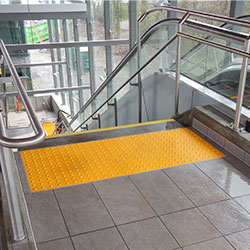









In Canada, over 8 million people live with some form of vision disease or impairment. This includes conditions like low vision, color blindness, partial sight, and legal blindness. For those with visual disabilities, navigating public spaces can prove challenging. However, thoughtful urban design and infrastructure modifications can make built environments more accessible.
One such indispensable accessibility tool is tactile warning systems. These specialized textured ground surfaces provide vital navigational cues and information to pedestrians with vision impairments. Tactile warning systems, also called detectable warning surfaces, are mandated in Canada by accessibility legislation like the Accessibility for Ontarians with Disabilities Act (AODA).
As a leading provider of accessibility solutions, Tactile Solution Canada offers a wide range of code-compliant tactile warning products for indoor and outdoor applications. Integrating proper tactile warning systems is key for Canadian contractors, architects, building managers, and owners striving to make infrastructure inclusive.
This blog explores the top 5 benefits of tactile warning systems in enabling accessibility and safety for the visually impaired.
Tactile warning systems allow individuals with vision loss to gather vital information about their immediate surroundings using senses like touch and hearing. The unique textures, like raised bumps or ridges, provide essential cues about potential hazards, directional guidance, and location orientation.
Equipped with these sensory cues from tactile surfaces, visually impaired pedestrians can navigate spaces confidently and independently. Tactile warning systems empower them with the freedom of movement to travel through public parks, transit stations, sidewalks, building interiors, and other urban infrastructure in a self-sufficient manner.
Tactile warning systems prominently highlight potential risks and hazards through standardized surface patterns that are easily identifiable non-visually. Warning indicators like truncated domes placed at locations like platform edges, staircases, and transit platforms caution users about impending dangers. This enhances safety by preventing potential missteps or accidents.
Guidance indicators like flat-topped bars installed along pedestrian walkways provide a safe path of travel for users to follow. This comprehensive hazard notification and directional guidance enabled by tactile warning systems is invaluable for mitigating safety risks.
Integrating proper tactile walking surfaces indicators (TWSIs) in public realm design and construction is mandated by Canadian accessibility legislation, including:
Accessibility for Ontarians with Disabilities Act (AODA)
Therefore, installing compliant tactile warning systems is not just about promoting inclusion but also meeting legal obligations. Using code-compliant tactile solutions demonstrates a commitment to creating accessibility.
Extensive research and testing have enabled the development of tactile warning standards and guidelines to create uniformity. The systematic, consistent use of solutions like truncated domes to indicate hazards and directional bars for path guidance provides crucial consistency.
Visually impaired individuals can rely on these familiar, standardized tactile patterns. The consistency enables them to intuitively interpret the cues from any city or province they visit. This boosts accessibility in public realm networks spanning communities.
While critical standards exist, tactile warning systems offer vast design flexibility. Solutions are available in diverse materials like durable polymer composites, slip-resistant metals, porcelain, and stainless steel. This allows for design customization and visual cohesion with surroundings.
Tactile products come in multiple sizes, colors, shapes, and installation methods to accommodate new builds or retrofits; whether an intricate art installation or a simple subway platform, customizable tactile warning systems suit diverse needs.
Common examples include detectable warning surfaces with truncated domes or directional guidance strips with elongated flat-topped bars installed on walking surfaces. Tactile warning pavers, tiles, and applied metal plates also serve as tactile warning systems.
Locations like sidewalk curb ramps, pedestrian crossings, transit platforms, building entrances, commercial spaces, parks, and parking areas require compliant tactile warning systems as per Canadian accessibility regulations.
Tactile warning systems can be constructed using materials like durable polymers, metals, porcelain, and rubber. The materials are chosen based on factors like application, code compliance, visibility, aesthetics, slip resistance, and accessibility standards.
Tactile warning systems provide standardized tactile and auditory cues to help visually impaired pedestrians detect potential hazards, navigate safely, avoid disorientation, and travel independently through public spaces.
With proper installation and robust materials like metals, quality tactile warning systems can last 10-15 years before needing replacement. More frequent replacement is needed for weaker materials like paints or plastics.
As Canada’s leading tactile solutions provider, Tactile Solution Canada offers premium products to make infrastructure accessible. Our extensive range includes:
Designed for easy installation, low maintenance, and long-lasting durability, our products make achieving accessibility compliance hassle-free. With in-house technical experts, we also provide guidance on integrating solutions into diverse urban contexts.
By investing in thoughtful tactile warning system design, urban planners, building managers, landscapers, and contractors in Canada can lead the charge in transforming public environments to be inclusive for all. Our team of accessibility specialists can help select compliant solutions tailored to your unique project needs.
To learn more about making infrastructure accessible with tactile warning systems, reach out to Tactile Solution Canada today!
